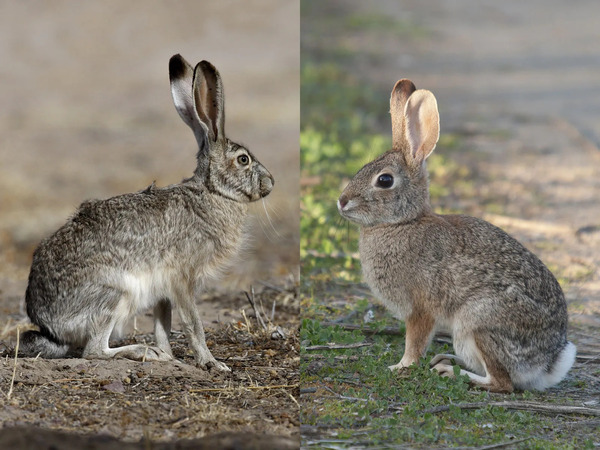When it comes to small, hopping mammals, people often confuse rabbits and hares. Though they might seem very similar at first glance, there are several distinct differences between the two. In this article, we’ll take a deep dive into the major differences between rabbits and hares, looking at their appearance, behavior, habitats, and more. Whether you're a curious pet owner or just an animal lover, understanding these distinctions can give you a better appreciation of these fascinating creatures.

Rabbits and hares both belong to the family Leporidae, but they are two distinct species within this family. Although they are related, their differences go beyond their names. Let’s explore the unique traits of each animal in detail.
While both animals share similar body structures, there are notable physical differences.
Size: Hares tend to be larger and have longer ears and legs than rabbits. These adaptations help hares run faster and survive in open environments where they have to evade predators.
Fur Color: Hares change color with the seasons. Many hares have brown or gray fur in the summer and white fur in the winter to help them blend into snowy environments. Rabbits generally remain the same color throughout the year.
Body Build: Hares are leaner and more muscular, adapted for running at high speeds, while rabbits are smaller and more compact.
The way rabbits and hares behave differs greatly, reflecting their respective environments.
Social Structure: Rabbits are known to live in groups, usually in burrows called warrens. They are social animals and rely on their community for protection. Hares, on the other hand, are solitary creatures and do not burrow. They prefer to make nests in simple depressions in the ground called "forms."
Speed: Hares are much faster runners than rabbits. This is due to their long legs, which allow them to sprint at high speeds to escape predators. Rabbits, while quick, prefer to dart into their burrows to evade danger.
Birth and Development: Rabbit babies, called kittens, are born blind, hairless, and helpless. They require their mother’s care for several weeks before they can fend for themselves. In contrast, hare babies, called leverets, are born with fur and open eyes, ready to hop around shortly after birth.
The living environments of rabbits and hares also set them apart.
Rabbits: Prefer environments with more cover, like forests, meadows, and areas with dense vegetation. Their need for shelter stems from their dependence on burrows to hide from predators.
Hares: Often found in open environments like grasslands, deserts, and tundra regions, where they rely on their speed and camouflage rather than burrows for protection.
Both rabbits and hares are herbivores, but their diets can vary slightly based on their habitats.
Rabbits: Typically feed on soft vegetation, such as grasses, herbs, and vegetables. Their diet often includes garden plants, which can make them pests in agricultural areas.
Hares: Are more likely to eat tougher plant material, such as bark, twigs, and hard stems, particularly in winter when softer vegetation is scarce.
| Characteristic | Rabbits | Hares |
|---|---|---|
| Size | Smaller, compact | Larger, more muscular |
| Ears and Legs | Shorter ears and legs | Longer ears and legs |
| Fur Color | Stays the same year-round | Changes with the seasons (brown/gray to white) |
| Social Behavior | Social, lives in groups in burrows (warrens) | Solitary, no burrows (lives in "forms") |
| Speed | Fast, but relies on burrows for protection | Extremely fast, relies on speed to evade danger |
| Birth Condition | Born blind and hairless, needs weeks of care | Born with fur and open eyes, independent early |
| Habitat | Forests, meadows, gardens, dense vegetation | Grasslands, deserts, tundra, open environments |
| Diet | Soft vegetation (grasses, herbs, vegetables) | Tougher plant material (bark, twigs, stems) |
| Defense Mechanism | Hides in burrows | Runs at high speeds |
| Domestication | Domesticated for pets and agriculture | Not domesticated, remains wild |
One of the most obvious differences is that rabbits are frequently domesticated, while hares are not. Domesticated rabbits have been bred for various purposes, including pets, food, and fur production. Hares, on the other hand, have never been domesticated due to their solitary nature and the fact that they are much more skittish and difficult to handle.
Pet rabbits are typically gentle, social creatures, making them suitable for family environments. Hares, with their fast speeds and nervous dispositions, are more suited to a wild, open environment where they can roam freely.
Though rabbits and hares share a family tree, they are distinct animals with notable differences in size, behavior, habitat, and even how they raise their young. Understanding these differences can help clear up common confusion between the two species and shed light on their unique adaptations. Whether you're admiring a rabbit in your backyard or spotting a hare darting through the fields, knowing what sets them apart can deepen your appreciation for these incredible creatures.
We created this article in conjunction with AI technology, then made sure it was fact-checked and edited by a Animals Top editor.